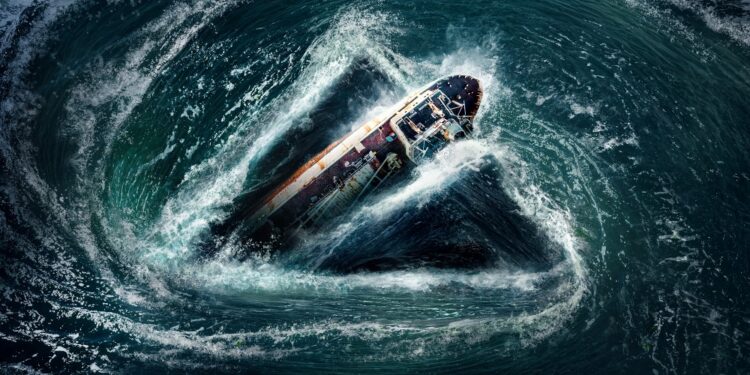The Bermuda Triangle, also known as the Devil’s Triangle, is a loosely defined region in the western part of the North Atlantic Ocean where numerous ships and airplanes are said to have disappeared under mysterious circumstances. Its boundaries typically stretch from the tip of Florida to Bermuda, and then to Puerto Rico, forming a triangle. The idea of the area as uniquely prone to disappearances arose in the mid-20th century, but most reputable sources dismiss the idea that there is any mystery. Over the years, this region has become synonymous with inexplicable incidents, leading to speculation ranging from paranormal theories to extraterrestrial involvement. However, science provides more grounded explanations for these phenomena.
Location and geography of the Bermuda Triangle
The Bermuda Triangle spans a large portion of the Atlantic Ocean, notorious for its unpredictable weather and dangerous waters. This area lies at the intersection of several major shipping routes, contributing to a high volume of traffic. Its location makes it subject to strong ocean currents, shifting trade winds, tropical storms, and deep underwater topography, all of which can contribute to hazardous conditions for ships and aircraft.
Natural explanations hehind the mystery
Scientists and researchers have explored various natural phenomena that could explain the numerous incidents associated with the Bermuda Triangle.
1. Rogue waves
One compelling explanation involves rogue waves, which are unusually large and unpredictable ocean waves that can rise up to 100 feet. These waves are often generated by the confluence of multiple storm systems. Given the Triangle’s location in the Atlantic Ocean – where storms from different directions meet – it is an ideal setting for rogue waves to form. Such waves are capable of swallowing even large vessels quickly, explaining why some ships may have disappeared without a trace.
2. Violent weather patterns
The Bermuda Triangle is located in the path of hurricanes, tropical storms, and other extreme weather conditions. The region’s warm waters can fuel storms of massive intensity. These storms can appear suddenly, leaving little time for pilots and sailors to react. Hurricanes are capable of destroying ships and planes, and historically, several major hurricanes have passed through this region. For instance, many of the disappearances coincide with periods of intense weather activity. Additionally, rapid weather changes are common in this region, including sudden, severe squalls and thunderstorms. These can contribute to disorientation and lead to accidents, particularly in the days before modern navigation technology.
3. Magnetic anomalies
One of the more frequently cited theories involves the Earth’s magnetic field. In the early days of navigation, mariners noticed that compasses would sometimes behave erratically in the Bermuda Triangle. This phenomenon is explained by the fact that the Bermuda Triangle is one of the few places on Earth where true north and magnetic north align. Known as “magnetic declination,” this difference between magnetic north and geographic north can confuse navigators, especially in the era before modern GPS systems. Errant navigation due to such anomalies could result in ships and planes going off course, potentially leading to accidents.
4. Methane hydrate eruptions
Another scientific theory points to methane hydrate deposits on the ocean floor. Methane hydrates are crystalline structures that trap methane gas beneath the seafloor. If a large pocket of methane gas is suddenly released due to underwater landslides or geological activity, the gas can decrease the density of the water, causing ships to lose buoyancy and sink rapidly. Studies suggest that methane gas eruptions could also affect aircraft by altering the atmosphere and leading to engine failure. Though there is limited direct evidence linking methane eruptions to specific Bermuda Triangle disappearances, this hypothesis remains an intriguing possibility.
Human factors and technological limitations
While natural phenomena like rogue waves and magnetic anomalies provide compelling scientific explanations for some of the incidents in the Bermuda Triangle, human factors and technological limitations have played equally significant roles in the region’s history of maritime and aviation accidents.
1. Human error
One of the most overlooked explanations for Bermuda Triangle incidents is simple human error. Navigation in the open ocean, especially before modern technological advancements, was challenging. Pilots and sailors had to rely on rudimentary instruments that were susceptible to miscalculations. Fatigue, disorientation, and miscommunication among crew members often compounded the problem. Aircraft accidents such as the famous case of Flight 19, where a squadron of U.S. Navy bombers disappeared, are often attributed to navigational mistakes rather than any supernatural cause.
2. Technological failures
Mechanical failure in airplanes and ships is another common explanation. Aircraft engines can stall, and ships can suffer from hull breaches or engine problems. Some disappearances, such as those involving smaller private planes or ships, may simply be due to technical malfunctions. The vast expanse of the ocean makes it difficult to recover wreckage, leading to the perception that these vessels have disappeared mysteriously.
The role of ocean currents
The Gulf Stream, a powerful, warm, and swift Atlantic Ocean current, flows directly through the Bermuda Triangle. Ships and planes that are disabled or wrecked in this region can be carried far from their original location, making it difficult for rescue teams to locate them. The Gulf Stream can move objects at speeds of up to 4 knots (around 7.4 km/h), which might explain why wreckage is often never found or is discovered far from where the vessel was last seen.
Debunking myths
Many incidents attributed to the Bermuda Triangle have been thoroughly investigated, and their causes were found to be far less mysterious than initially thought.
- Flight 19 (1945): The most famous disappearance in the Bermuda Triangle, Flight 19, involved a group of U.S. Navy bombers that lost communication and vanished during a training mission. Investigation points to human error and navigational mistakes due to bad weather and malfunctioning instruments. The planes likely ran out of fuel and crashed into the ocean.
- SS Marine Sulphur Queen (1963): This tanker ship disappeared while carrying molten sulfur. Investigations revealed that the ship was poorly maintained and structurally unsound. A ship in such condition, combined with rough sea conditions, could have easily sunk.
Disproportionate attention
Part of the Bermuda Triangle’s mystique stems from media sensationalism. Books, movies, and television shows have often played up the mystery, focusing on the inexplicable while ignoring mundane explanations. Research conducted by the U.S. Coast Guard and other maritime authorities has found that the number of incidents in the Bermuda Triangle is not significantly higher than in any other heavily traveled part of the world. This debunks the myth that the region is unusually dangerous.
Scientific consensus
The scientific community largely agrees that there is no need for supernatural explanations to account for the accidents in the Bermuda Triangle. Most disappearances can be attributed to a combination of human error, environmental factors, and mechanical failure. The convergence of storms, magnetic anomalies, and ocean currents in a busy maritime area is enough to explain the historical record of incidents.
Conclusion
While the Bermuda Triangle has long been surrounded by mystery, science offers logical explanations for the incidents reported in the area. From rogue waves and methane hydrates to human error and technological failures, there is no shortage of natural explanations for the Triangle’s events. Though its reputation as a zone of unsolved disappearances persists in popular culture, scientific evidence suggests that the Bermuda Triangle is no more dangerous than any other heavily trafficked part of the world’s oceans. With improved navigation and communication technologies, the mysteries of the Bermuda Triangle continue to be unraveled.




































































































































































































